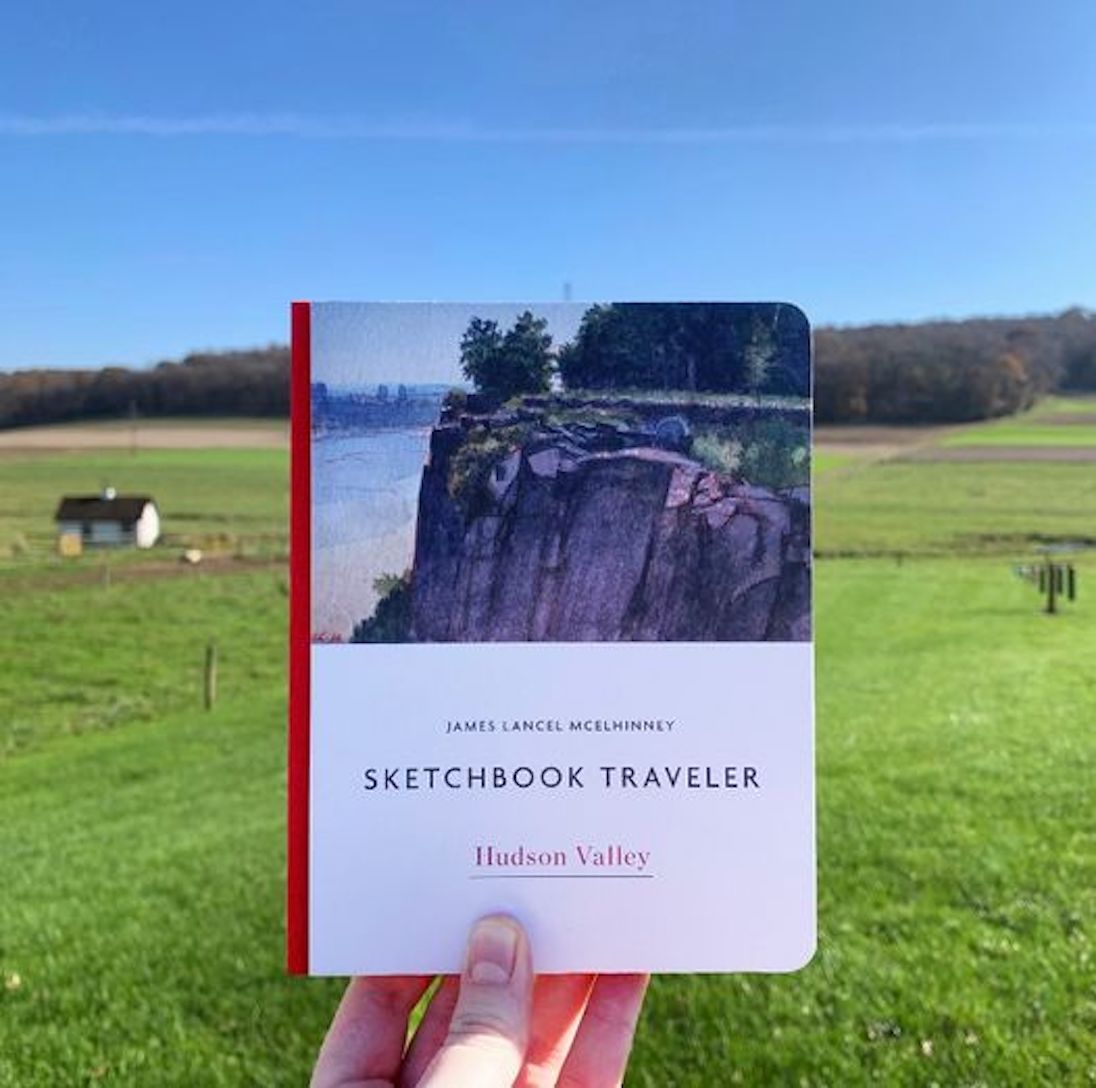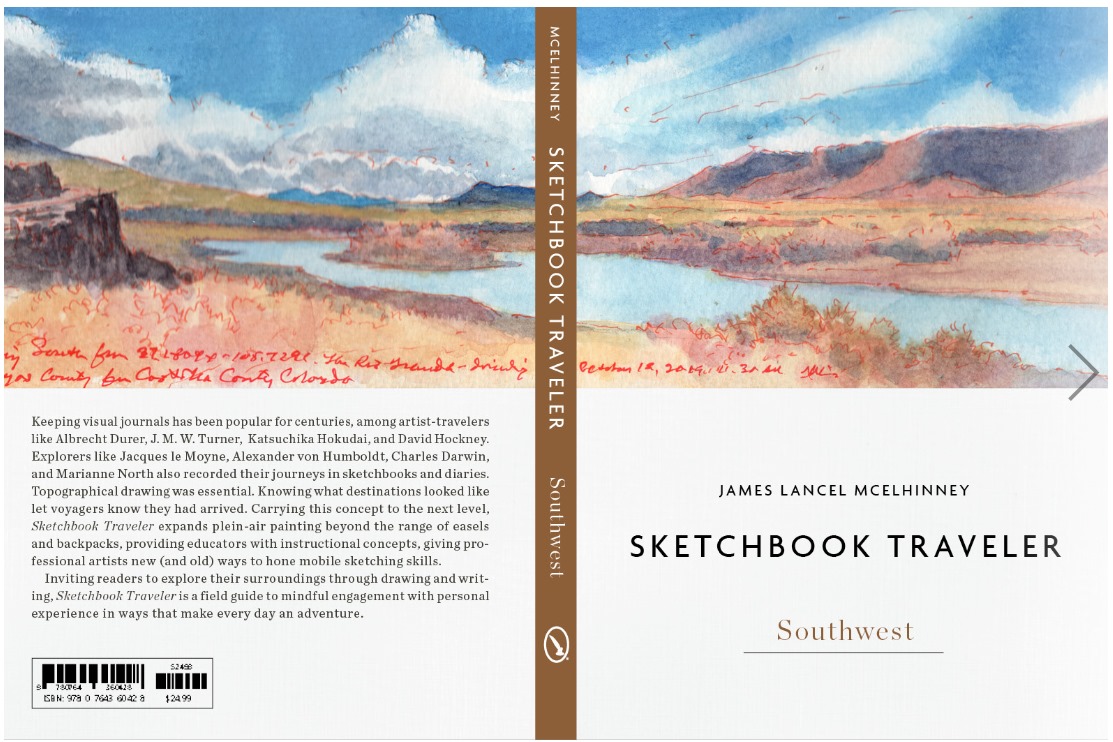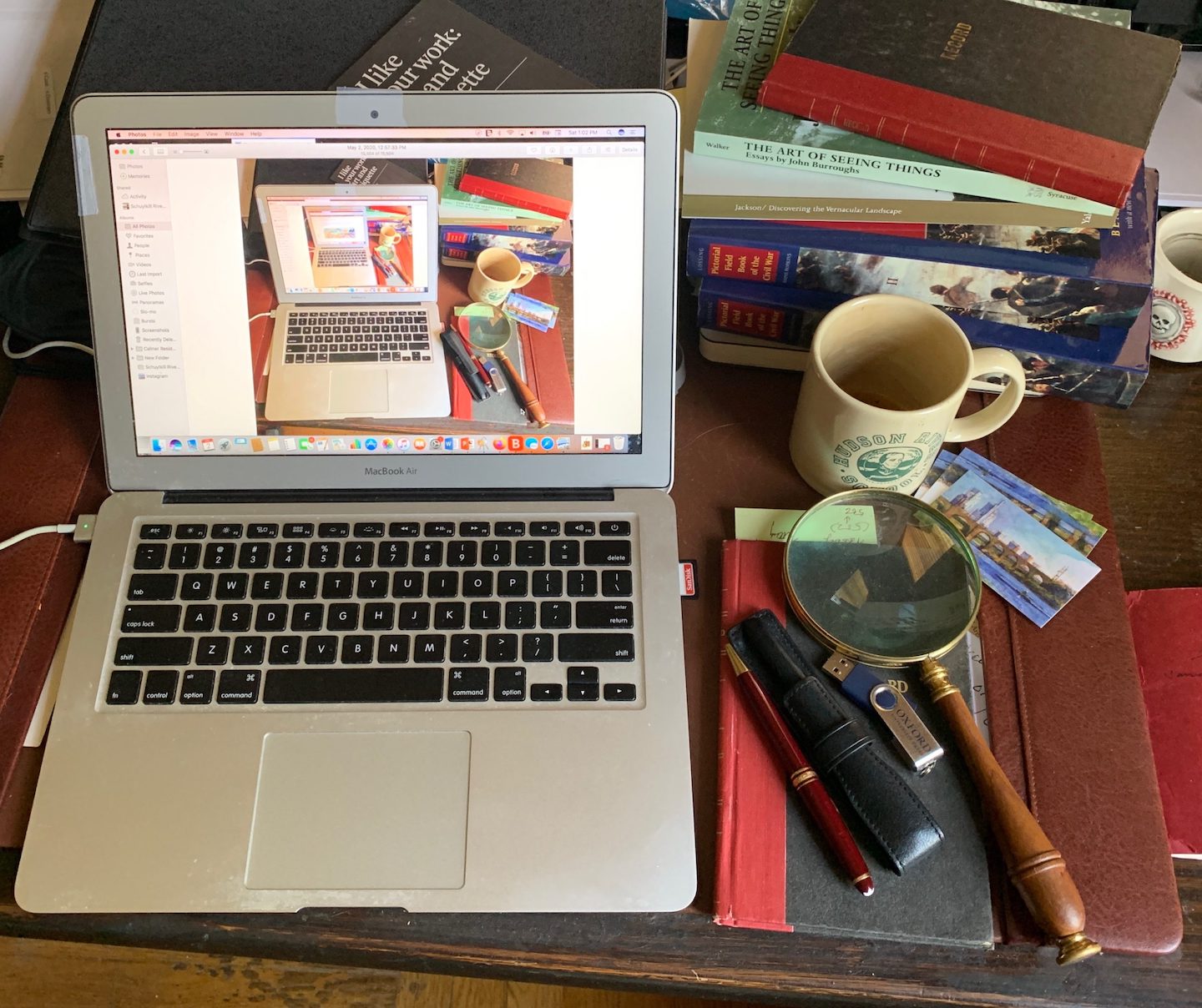
Champlain Canal below Bemis Heights, Saratoga National Historical Park. Watercolor on Lana watercolor paper. 12 x 16 inches. 2021.
This painting, which will be reproduced on interpretive signage created by the Erie Canal National Heritage Corridor, represents a slight departure in that it imagines a specific location as it may have looked circa 1840. Maps of the period revealed that the terrain depicted was nearly treeless. A few arboreal touches were included to help visitors transition from today’s semi-wooded setting to its nineteenth century appearance.
On September 10, 1823, the sixty-mile Champlain Canal finally opened to traffic, linking the Hudson River at Fort Edward with Lake Champlain at Whitehall, formerly known as Skenesboro. Built in stages starting in 1817, the canal increased the volume of goods and raw materials that moved from the navigable tidal estuary that ascended the Hudson from New York harbor to north of Cohoes. Unlike the Erie Canal, which would open two years later, the Champlain Canal was built to accommodate schooner-rigged canal boats. Spars and masts were laid lengthwise on deck. Sails and rigging were stashed in a forward compartment, where the hired man also slept. Masts would be stepped at Whitehall, secured by stout deck-mounted tabernacles. Spars and rigging were designed for quick assembly. Descending Lake Champlain under sail, steering and stability was assisted by a large centerboard that could be lowered in deep waters. Centerboards are common features in today’s recreational sailboats. As an historical aside, the concept was first put to use in gunboats being assembled for the royal navy by John Schanck (1746-1823), for use against the American rebels that controlled Lake Champlain. Several men-or-war were taken apart on the Saint Lawrence River and reassembled at Saint John’s on the Richelieu River. With them Schank’s centerboard gunboats would defeat Benedict Arnold’s mosquito fleet at the Battle of Valcour Island on October 11, 1776.

Admiral John Schank (1746-1823) Inventor of the centerboard
The rudders of Lake Champlain sailing canal-boats were equipped with a similar innovation in the form of an extension that could be flipped aft to double its length. This enhanced steering the vessel at slow speed while passing the canal, with no more than a foot or two of leeway. Running along the length of the hull above the waterline were longitudinal rub-rails; thick wooden bumpers to absorb the shock of occasional collisions with banks and bulkheads.

Sailing canal-boat Lois McClure, Lake Champlain Maritime Museum, Vergennes, Vermont
I had made an appointment with Lake Champlain Maritime Museum collections manager Patricia Reid to look at some of the visual documents in the museum collection related to sail-powered canal boats. Arriving at the museum near Vergennes at 10:35 on the morning of October 27, I was greeted by schooner management and volunteer coordinator Elisa Nelson, who brought me into a meeting room with books set out on a large refectory table. After perusing the volumes, accompanied by a lively and informative conversation, Elisa and I went outdoors to take a look at the museum’s working replica of an 1862 series sailing canal boat, the Lois McClure, named for one of the donors who underwrote its construction.

Gunboat Philadelphia. (1776) Smithsonian Museum of American History. Washington DC. Below: Replica of the gunboat Philadelphia awaiting repairs at Lake Champlain Maritime Museum.

The day was windy as we walked across the campus, past boat shed and workshops. We paused to inspect the museum’s replica of the gunboat Philadelphia. The original is in the Smithsonian National Museum of American History. After years in the water, the full-scale reproduction was looking more and more like its predecessor. Copper sheeting had been attached to the bottom of the wooden hull to hinder its deterioration. Nelson related how when the original Philadelphia was being fitted out for active service, the shipwrights discovered that in their haste, they had made provisions for a bow gun in the stern. To correct their blunder, a notch had to be chopped out of the stem post to accommodate the cannon tube. The replica copied this exactly.
“These boats were never built to last,” Nelson commented. “They were built for the battle.”
Diving into the woods, we followed a steep gravel paved roadway descending to the shoreline of North Harbor. Jutting out into the water, a pier led to a long floating dock, which rocked on the waves. Moored along the south side of the dock was the Lois McClure. Stout tee bar racks supported the masts and spars.
“Those supports are not historically accurate.” Elisa explained. “When the boat was coming the canal, all that would have been just lying on the deck, with the sails and rigging stowed in the forward compartment, which would also have been where the hired man slept.”
Having closed for the season, in preparation for winter the museum crew had started dismantling bits and pieces, including twenty feet of hand rail that ran up the middle of the dock. Whitecaps appeared atop choppy, two to three foot waves. Across the lake, a sheer escarpment rising more than a hundred feet added to this sublime, unruly and dangerous expression of nature. Nelson nixed the idea of making a dash for the stairway that would have put us on the deck. “I always rope off those steps,” she explained. “You see any ropes? This crazy wind has blown them off. It’s too bad we can’t go aboard, but it’s just not safe.”
Before winter sets in, the schooner will be towed to Basin Harbor, the next anchorage to the south. There it will spend the winter out of the water, before undergoing maintenance and repairs before returning to the museum dock.

Arthur B. Cohn
Lake Champlain Sailing Canal Boats. Lake Champlain Maritime Museum. Basin Harbor, VT. 2003
Back in the office, I purchased a membership, and a copy of the book Lake Champlain’s Sailing Canal Boats: An Illustrated Journey from Burlington Bay to the Hudson River – Building the Canal Schooner Lois McClure by former executive director Arthur B. Cohn, and others. Thanking my hosts for an informative visit, I made my way to the parking area. Climbing into my car, I backed up slowly as another vehicle pulled in beside me. Strapped to the top was a large kayak. Unlike the ubiquitous tutti-frutti synthetic variety seen zipping around the Green Mountains and Adirondacks, this one appeared to be made of natural materials, painted in modest earth tones. The driver noted my interest and nodded. I nodded back and continued my journey.

Button Bay, formerly Buttonmould Bay. In June 1777, elements of General John Burgoyne’s army camped along these shores during its progress up the lake toward Ticonderoga.
Heading back to Crown Point, I was curious to visit the little bay where the British navy caught up to Benedict Arnold on October 13, 1776. The gunboat Philadelphia, reproduced at Lake Champlain Maritime Museum, had already been lost when the British fleet caught up the remnants of the leaky, battered rebel fleet just south of Split Rock. The fight that ensued cost more American lives. Lieutenant Thomas Rogers was blown to smithereens when a Swedish-made cannon exploded on the gunboat New York. Facing certain defeat, Arnold ran his remaining boats ashore, put them to the torch and beat a hasty overland skedaddle to Crown Point.
Today the road to Arnold Bay runs along a narrow gravel-paved course through the wooded margins of the lake. To the left on the descent is a massive concrete building that houses the water treatment facility for the town of Panton, Vermont. Parking on the little point on the northern corner of the circular bay, I found a bronze and stone Sons of the American Revolution marker identifying the site as where Arnold had come ashore on October 13. Reaching into the bay were two piers. Small single class racing boats were secured to the more distant pier, managed by the sailing program at Middlebury College. Riding at anchor in the middle of the bay was a solitary cruising sloop of thirty feet or more. Its tender was stashed onshore, just below the water treatment plant. To the north, the shoreline rose vertically in one of the ubiquitous fossil-reef limestone layer-cakes that rim the lakeshore.

Arnold Bay, Panton, Vermont. Looking west toward the Adirondacks.
Taking note of my surroundings a veteran subcompact import rolled to a stop, ten feet from my Subaru. From it emerged the same cheerful hirsute fellow, with whom I had exchanged nods in the parking lot at the maritime museum. Strapped to the roof was the same kayak. Its owner was Ron Rost, a longtime member of the dance department staff at Middlebury College. Replying to my query about the kayak he replied,
“This was handmade by one of the guys up in the boat shop at Champlain Maritime Museum. Because of its size, it’s stable enough for the lake. It’s roomier inside that you might think.”
Rost explained how after graduating from college in 1979, he had come to the Champlain Valley to work on a Delaware Bay oysterman. Having grown up in the Delaware Valley, I was familiar with these boats with their beamy hulls, shallow drafts and raking masts. They were a common sight also in Chesapeake Bay, where they were known regionally as skipjacks. The schooner whose crew Rost had joined traveled up and down the lake, stopping at different ports of call to take on visitors for tours and day cruises.It struck me as odd that someone would think it was a good idea to bring a craft designed for coasting over shoals to a deep and often turbulent body of water with its own regional history of nautical architecture. The bicentennial years of the late seventies had seen their parades of tall ships. Suddenly every urban waterfront in America needed tourist-friendly seaport zones with their own tall ships. It seemed to me that a Delmarva Skipjack on Lake Champlain was like a benign invasive species, unlike the Zebra Mussels and Asian Watermilfoil that had made their way into its waters. I kept these thoughts to myself.
 Rost explained that when I had seen him at the museum, he was paying a visit to friends on the boat shop. He was now in search of a likely place to launch his kayak and planned to travel from bay to bay in search of calmer waters. We spoke about the battle at Valcour, and the action that took place just offshore. Directing me to a few other bays and landings he though worth exploring, he noted that the tranquility of Arnold’s Bay looked like an inflatable kiddie pool, compared to the churning cauldron stretching back to Westport on the Adirondack Coast. As Rost cogitated on the merits and perils of putting in, I bade him farewell and continued on to Crown Point. Crossing the narrows from Chimney Point into New York State, the king’s colors danced above the massive fort in a fierce west wind.
Rost explained that when I had seen him at the museum, he was paying a visit to friends on the boat shop. He was now in search of a likely place to launch his kayak and planned to travel from bay to bay in search of calmer waters. We spoke about the battle at Valcour, and the action that took place just offshore. Directing me to a few other bays and landings he though worth exploring, he noted that the tranquility of Arnold’s Bay looked like an inflatable kiddie pool, compared to the churning cauldron stretching back to Westport on the Adirondack Coast. As Rost cogitated on the merits and perils of putting in, I bade him farewell and continued on to Crown Point. Crossing the narrows from Chimney Point into New York State, the king’s colors danced above the massive fort in a fierce west wind.
James Lancel McElhinney (c) 2021
Now available to own: Sketchbook Traveler: Hudson Valley

Coming Soon: Spring 2022: Sketchbook Traveler: Southwest

Explore my Quaranteam Dispatches, from April 1-June 8, 2020

 Facebook
Facebook Twitter
Twitter Linkedin
Linkedin